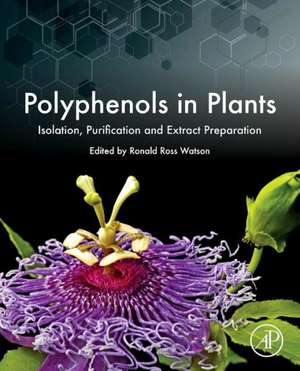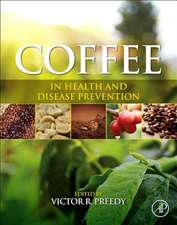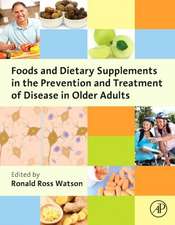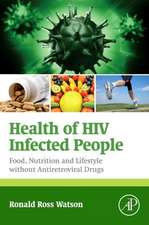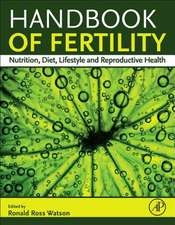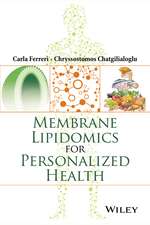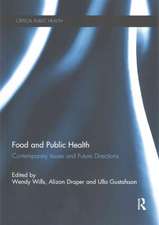Polyphenols in Plants: Isolation, Purification and Extract Preparation
Editat de Ronald Ross Watsonen Limba Engleză Hardback – 19 mar 2014
Polyphenols play key roles in the growth, regulation and structure of plants and vary widely within different plants. Stress, growth conditions and plant species modify polyphenol structure and content. This book describes techniques to identify, isolate and characterize polyphenols, taking mammalian toxicology into account as well.
- Defines conditions of growth affecting the polyphenol levels
- Describes assay and instrumentation techniques critical to identifying and defining polyphenols, critical to researchers and business development
- Documents how some polyphenols are dangerous to consume, important to dietary supplement industry, government regulators and lay public users
| Toate formatele și edițiile | Preț | Express |
|---|---|---|
| Paperback (1) | 697.92 lei 5-7 săpt. | |
| ELSEVIER SCIENCE – 17 aug 2018 | 697.92 lei 5-7 săpt. | |
| Hardback (1) | 559.01 lei 5-7 săpt. | |
| ELSEVIER SCIENCE – 19 mar 2014 | 559.01 lei 5-7 săpt. |
Preț: 559.01 lei
Preț vechi: 694.19 lei
-19% Nou
Puncte Express: 839
Preț estimativ în valută:
106.98€ • 111.28$ • 88.32£
106.98€ • 111.28$ • 88.32£
Carte tipărită la comandă
Livrare economică 07-21 aprilie
Preluare comenzi: 021 569.72.76
Specificații
ISBN-13: 9780123979346
ISBN-10: 012397934X
Pagini: 360
Dimensiuni: 191 x 235 x 25 mm
Greutate: 0.89 kg
Editura: ELSEVIER SCIENCE
ISBN-10: 012397934X
Pagini: 360
Dimensiuni: 191 x 235 x 25 mm
Greutate: 0.89 kg
Editura: ELSEVIER SCIENCE
Public țintă
Food scientists, Plant scientists including those with an interest in food/dietary disease prevention, Nutritionists, Dieticians, Health scientists/researchers whose focus is improved health outcomes based on dietary change/impact.Cuprins
Part 1: Modification by plant growth and environment
1. Cultivar and production effects on bioactive polyphenols
2. Plant polyphenol profiles as a tool for traceability and valuable support to biodiversity
Section A: Stress and polyphenol in plants
3. Phenolic compounds and saponins in plants grown under different irrigation regimes
4. Lichen phenolics: environment effects
Section B: Plant systems of polyphenol modification
5. Modulation of plant endogenous antioxidant systems by polyphenols
6. Plant polyphenols: do they control freshwater planktonic nuisance phototrophs?
Part 2: Isolation and analysis of polyphenol structure
Section A: Analysis techniques for polyphenols
7. Gas chromatography - mass spectrometry analysis of polyphenols in foods
8. Novel techniques towards the identification of different classes of polyphenols
9. Characterization of polyphenolic profile of citrus fruit by HPLC/PDA/ESI/MS-MS
Section B: Isolation and extraction techniques
10. Non-extractable polyphenols in plant food: nature, isolation and analysis
11. Resin adsorption and ion exchange to recover and fractionate polyphenols
12. Polyphenolic compounds from flowers of Hibiscus: characterization and bioactivity
13. Hydrothermal processing on phenols and polyphenols vegetables
Part 3: Polyphenols identification and occurrence
14. Improved characterization of polyphenols using liquid chromatography
15. Characterization and quantification of polyphenols in fruits
16. Determination of polyphenols, flavonoids, and antioxidant capacity in seeds
1. Cultivar and production effects on bioactive polyphenols
2. Plant polyphenol profiles as a tool for traceability and valuable support to biodiversity
Section A: Stress and polyphenol in plants
3. Phenolic compounds and saponins in plants grown under different irrigation regimes
4. Lichen phenolics: environment effects
Section B: Plant systems of polyphenol modification
5. Modulation of plant endogenous antioxidant systems by polyphenols
6. Plant polyphenols: do they control freshwater planktonic nuisance phototrophs?
Part 2: Isolation and analysis of polyphenol structure
Section A: Analysis techniques for polyphenols
7. Gas chromatography - mass spectrometry analysis of polyphenols in foods
8. Novel techniques towards the identification of different classes of polyphenols
9. Characterization of polyphenolic profile of citrus fruit by HPLC/PDA/ESI/MS-MS
Section B: Isolation and extraction techniques
10. Non-extractable polyphenols in plant food: nature, isolation and analysis
11. Resin adsorption and ion exchange to recover and fractionate polyphenols
12. Polyphenolic compounds from flowers of Hibiscus: characterization and bioactivity
13. Hydrothermal processing on phenols and polyphenols vegetables
Part 3: Polyphenols identification and occurrence
14. Improved characterization of polyphenols using liquid chromatography
15. Characterization and quantification of polyphenols in fruits
16. Determination of polyphenols, flavonoids, and antioxidant capacity in seeds
